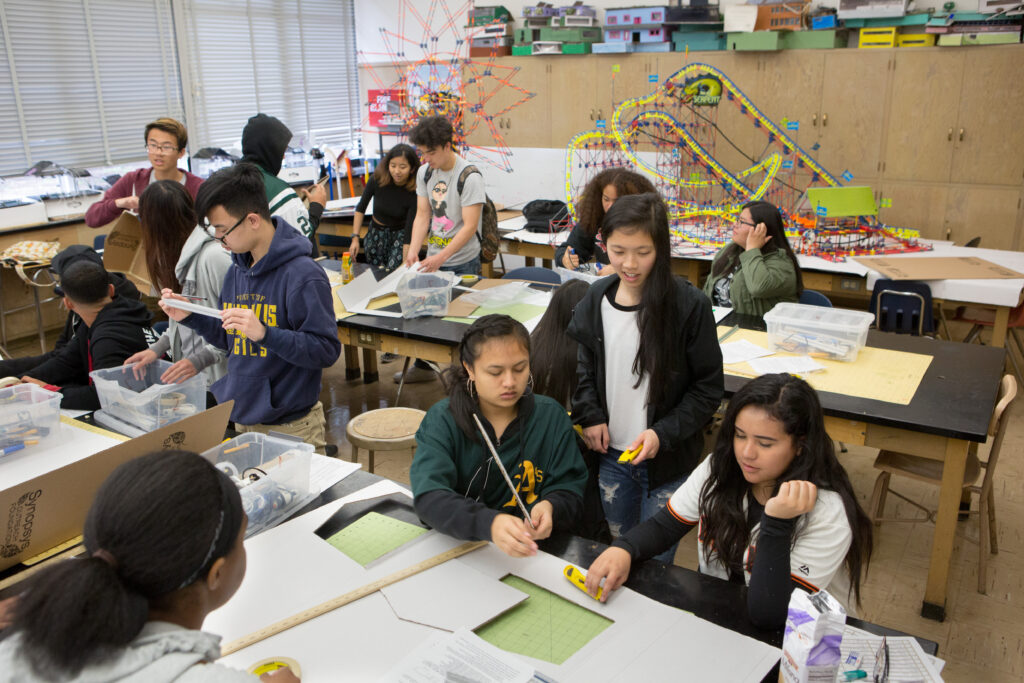
High school students in a math class.
Credit: Allison Shelley / EDUimages
As California schools continue their post-pandemic recovery, a troubling pattern has emerged: High schoolers aren’t showing up.
Recent midyear attendance data reveals that while elementary school attendance has improved significantly, high school chronic absenteeism remains stubbornly high.
Nationally and in California, chronic absenteeism numbers tell a concerning story about older students. While California’s average chronic absence rate, based on the sample in the new report, fell to 20.46% (down from 29.04% in 2022-23), high school students continue to struggle.
Over 28% of California high school seniors included in the report have been chronically absent this school year. We must rethink approaches to engaging older students to improve high school attendance.
When students miss school, they miss more than just instruction. They miss opportunities to connect with supportive adults and peers — connections directly linked to academic success and well-being.
Research from YouthTruth, which surveys elementary, middle and high school students, reveals that only 40% of high school students feel they belong at school, compared with 47% of middle schoolers. Only 22% of high school students report that their teachers understand their lives outside school — the lowest percentage since before the pandemic.
Traditional attendance approaches that work for elementary students don’t resonate with teenagers navigating complex social pressures, growing independence, and increasing responsibilities. Many high school students juggle jobs, family care duties and mental health challenges that are not as prevalent in younger grades.
The California Safe and Supportive Schools initiative identifies school connectedness as fundamental to attendance. When high schoolers have even one strong connection with a teacher or staff member who understands their life beyond academics, attendance improves dramatically. Schools can implement connection mapping to identify which students could benefit from more connections.
Schools can also leverage peer influence. According to YouthTruth, 68% of high school students want to help improve their communities, but only 30% report having opportunities to create positive change. Student-led attendance initiatives consistently outperform adult-directed programs. For example, a peer-led “attendance influencer” program has an impact exceeding what other systems can achieve.
Educators must also seek to understand and address the specific attendance barriers older students face. Many chronically absent teens are helping to support their families, caring for siblings or facing transportation limitations. Flexible scheduling options, transportation assistance and partnerships with local employers can help address these obstacles.
Communication must shift from punitive to supportive to effectively reach students and families. A recent K-12 family survey revealed that more than 71% of families want messages celebrating good attendance or improvements to share with their child, while only 37% of respondents reported receiving regular communication about steps they can take to improve attendance. Schools that successfully address absenteeism use data to identify patterns and engage students and families in collaborative solutions-finding rather than blame.
Finally, we must address the mental health component of attendance. Nearly half of all California students (48%) cite depression, stress or anxiety as obstacles to learning — yet only 41% of students nationally report having an adult at school to talk to.
This “support gap” is particularly pronounced among at-risk student populations. About 77% of LGBTQ+ students cite mental health challenges as barriers to learning, compared with 41% of their peers. While 46% of white students report having an adult at school they can talk to, the percentage is significantly lower for other racial groups, between 37-44%.
The good news? When targeted strategies are implemented, improvement can happen quickly. Effective approaches to building a culture of belonging include:
- Teacher-student connection time: Brief but regular one-on-one check-ins to understand students’ lives outside school.
- Student voice channels: Creating opportunities for students to provide feedback and lead attendance initiatives that resonate with peers.
- Positive communication: Shifting from absence-focused messages to celebrating improvements and recognizing attendance gains.
- Data-driven intervention: Using integrated attendance, academic and behavioral data to identify early warning signs and track what works.
As California continues to invest in attendance improvement, we must tailor our approaches to different grade levels. Our high schoolers don’t want automated calls or perfect attendance certificates. They need meaningful connections, relevant engagement and practical support for real-life barriers.
California’s future leaders walk our high school hallways — when they show up. Meeting these students where they are isn’t just good policy, it’s our obligation to the next generation of leaders, innovators and citizens.
•••
Kara Stern is director of education and engagement at SchoolStatus, a company that provides school districts with data tools and communication support for student engagement.
The opinions expressed in this commentary represent those of the author. EdSource welcomes commentaries representing diverse points of view. If you would like to submit a commentary, please review our guidelines and contact us.



